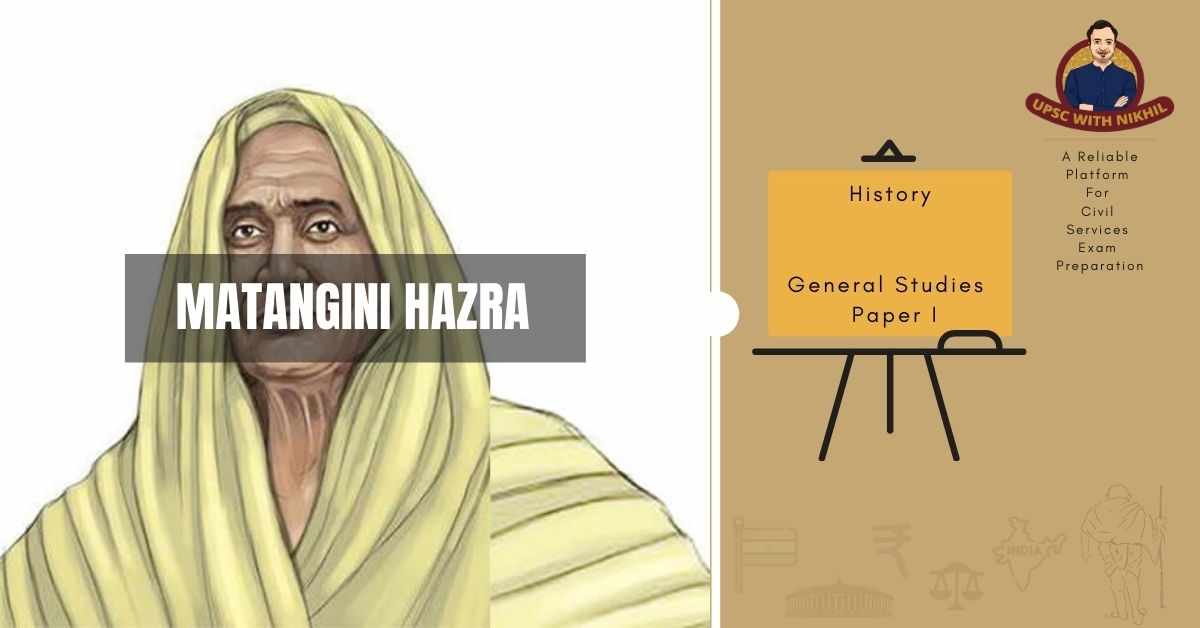Matangini Hazra
Matangini Hazra was an Indian revolutionary and social activist who participated in the Indian independence movement. During Quit India Movement, on 29 September 1942, she was shot dead by the British Indian police in front of the Tamluk Police Station (Midnapore District). She was 73 years old then.
• She was born as Matangini Maity on19th October 1869 in penury in Hogla village located under Tamluk police station in Midnapore district, West Bengal.
• Due to her family’s abject poverty, she could not even get primary education. As a result, she remained unlettered and unschooled all her life.
• She was married at 12 to Trilochan Hazra, a 60-year-old man from Alinan village in Medinipur.
• By age 18, Matangini Hazra was widowed, without any children.
• After her husband’s death, she returned to her parental village. Over the next few years, she spent the greater part of her time in helping people.
AS A FREEDOM FIGHTER
• In 1905, she became actively interested in the Indian Independence Movement, her source of inspiration being Mahatma Gandhi. A notable feature of the freedom struggle in Midnapore was the participation of women and Matangini was one among them.
• In 1932, she took part in the Civil Disobedience movement and was arrested for breaking the Salt Act. She was promptly released, but she again protested for abolition of chowkidari tax and then she was arrested.

• She was incarcerated for six months at Baharampur. After being released, she became an active member of the Indian National Congress and took to spinning her own Khadi.
• Greatly inspired by Mahatma Gandhi, she started spinning yarn despite her weak eyesight and wore khadi clothes, apart from religiously following his teachings. People fondly started calling her Gandhi Buri (Old Lady Gandhi) for her dedication towards Gandhian principles.
• Matangini used to lead huge processions and actively participated in the Quit India and Non-cooperation movements.
• During the Salt Satyagrah, she stealthily got into the premises of Tamluk Court without arousing suspicion of the police guarding the building and hoisted the national flag. She was eventually caught and arrested by the police. Her active participation in different protests led to her arrest on many occasions, but the police used to eventually release her, keeping her old age in mind.
• In 1933, she attended the sub-divisional Congress conference at Serampore and was injured in the ensuing baton charge by the police.
• In 1933 when Sir John Anderson, Governor of Bengal visited Tamluk to address a public gathering, Matangini craftily managed to avoid the security and reach the dais where she waved a black flag. She was awarded six months rigorous imprisonment for her bravado.
• As part of the Quit India Movement, members of the Congress planned to take over the various police stations of Medinipore district and other government offices.
• On September 29, 1942, she led a procession of around 6000 supporters towards Tamluk police station. As she surged forward, the police shot at her. But the gunshot did not stop her from moving ahead. She was again shot at, but she didn’t stop and raised her voice saying ‘Vande Matram’. She held the flag aloft as she was shot at for the third time. She finally succumbed to her injuries and died with the flag in her hand.
• She was truly a woman of great courage, unmatchable valour and grit. She had inspired many others to follow in her footsteps in the fight against British rule in India.
• Hazra’s killing made her a martyr for many, inciting revolutionaries to establish their own local government in Medinipur.
• India earned Independence in 1947 and numerous schools, colonies, and streets were named after Hazra.
• The first statue of a woman put up in Kolkata, in independent India, was Hazra's in 1977. A statue now stands at the spot where she was killed in Tamluk.
• In 2002, as part of the commemoration of sixty years of the Quit India Movement, a series of postage stamps was issued by the postal department. Among them was a five rupee postage stamp with Matangini Hazra’s facsimile.
• Hazra Road, a major road in south Kolkata is named in the memory of the valiant freedom fighter.


